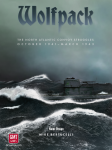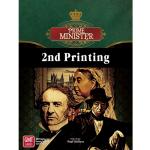![]()
![]()
![]()
![]()
![]()
![]()
Unconditional Surrender! Western Campaigns
Unconditional Surrender! Western Campaigns (USWC) is an operational/strategic-level game covering World War 2 campaigns fought between the Axis and Western Allied factions in Western Europe. With its emphasis on force projection, players focus on the big picture of managing their military forces. Using simple mechanics and low on-map counter density, players easily handle the action without complicated subsystems or tall stacks of counters.
Plucked from the game Unconditional Surrender! World War 2 in Europe (USE), USWC provides shorter, smaller footprint scenarios for those wanting to play the Unconditional Surrender! design but lacking the space and time needed for the much larger USE. USWC also serves as an alternative way to teach it to other players.
From the air and ground mechanics in Poland 1939 to the airborne-assisted invasion in Denmark-Norway 1940, players learn the basic operational rules to the game that they can tune in the Balkans 1941 or French North Africa 1942 campaigns. They can then take that experience to larger, competitive scenarios like France 1940 and France 1944. You will decide how far to push your successful spearheads, not knowing how far the rest of your units will advance. You will have to decide what the right balance between timidity and recklessness is and where to commit your air and other assets for success.
Unconditional Surrender! Western Campaigns features the low counter density that is a hallmark of the system, while providing event markers for such assets as airdrops and ULTRA—all of which are woven into the game's core mechanics for ease of play. As the game covers individual campaigns, nearly all scenarios use only a single 8.5” x 11” map and common 8.5” x 11” tracking display. For those familiar with USE, the ground and air rules remain the same, while more strategic elements (e.g. diplomacy, strategic warfare, and naval operations) have either been abstracted or removed to simplify the rules and reduce playing time.
Unconditional Surrender! Western Campaigns has six scenarios ranging from Poland 1939 to France 1944.
DESIGN HIGHLIGHTS
Low On-Map Counter Density: The number of counters on the map is incredibly low.
Simple Stacking: No more than one of the same type of unit per hex.
No Factors on Counters: No combat or movement factors on counters.
Single Combat System: One combat resolution sequence and Combat Results Table covers all types of combat, yet the results differ for air or ground combat.
Integrated Movement & Combat System: Units move and fight in a combined activation.
Ergonomically Friendly: Easily fits in extremely limited gaming space.
"Use it or lose it." Economic System: Simple math with minimal record keeping.
Solitaire Friendly: Though not designed with solitaire rules, it is easy for one player to play both sides.
PBEM Capable: The game can be played using PBEM software, but its mechanics may require frequent exchanges.
Easy to Modify: The relatively simple mechanics make it easy to modify the game.
Unconditional Surrender! World War 2 in Europe Compatibility: The ground and air units, event markers, and combat system are the same in both games. The scenarios are similar except for the elements that were abstracted. If you later decide to play USE, you will have additional rules to learn but little to unlearn.
GAME BASICS
Map: The map covers the European continent and portions of Africa.
Markers: Special WW2 events and chrome (such as airdrops, jets, partisans, or ULTRA) are represented using Event markers. These markers are a combat die roll modifier or have a short rule that can be looked up when played.
Units: There are two kinds of units: Air and Ground. A ground unit is represented at the army level but may consist of forces ranging from a brigade to a full army. An air unit is represented as a group, fleet, or other designation.
Most ground units have a full strength side and a reduced strength side. When a full strength unit suffers a loss, it is reduced. If a reduced strength unit suffers a loss, it is eliminated. Ground units are broken down into two groups: Leg and Mobile. Leg units are infantry, paratroop, and garrison forces. Mobile units are motorized and tank forces.
There are two types of air units: Fighter and Bomber. A fighter or bomber can attack an air unit or provide air support to a ground combat.
Stacking: A hex can have no more than one bomber, fighter, and ground unit. Stacking limits are always in effect, with few exceptions. Therefore, friendly armies could get in each other’s way.
Movement: There are two kinds of movement: Strategic and Operational. Strategic allows a unit to move any distance along a contiguous rail or road line. Operational allows a unit to move up to its movement allowance.
There are no movement allowance numbers on the counters. There are only two values to remember, eight and ten. Leg ground units have an allowance of eight, and every other kind of unit (including air) has an allowance of ten.
Combat Resolution: The game uses a die result comparison system with no combat factors on the counters. Advantages due to troop quality, equipment, tactical doctrine, etc. are handled through combat die roll modifiers (DRM).
All types of combat follow the same resolution sequence and utilize the same Combat Results Table (CRT). The attacker and defender each roll a six-sided die, and each adds its own specific DRM based on the units involved and the type of combat fought. Each side’s modified die roll result is then cross-referenced on the CRT. The found CRT result is then applied based on the type of combat fought.
Unit Activation: The game does not use a “Move everyone; fight everyone” system. Instead, a faction activates one unit to perform an “Action” which allows it to move and/or fight. Once it completes that unit’s activation, the faction activates another unit. Units can be activated in any order. For example, the Axis faction activates an air unit to attack an enemy air unit. It then activates a ground unit to move and fight. This is followed by an airdrop and then with an air unit attacking another enemy air unit.
Given a unit must activate and complete its action before another unit activates, players operate under some fog of war. They will not know if supporting armies will hold their ground or advance far enough on the attack.
Sorties: The effectiveness of an air unit is tracked using Sorties markers, valued at 1 through 6. A unit with no Sorties is fully effective. A unit marked with 6 Sorties cannot be activated to perform any action. As an air unit conducts actions or is involved in combat, it will add Sorties to its total. Having Sorties reduces the number of future actions a unit can perform and decreases its combat performance. A unit can only remove a few Sorties from its total each turn, so a heavily used or engaged unit takes time to recoup to full effectiveness.
TIME SCALE: Monthly Turns
MAP SCALE: 30 to 40 miles per hex
UNIT SCALE: Army, Fleet, or Wing
NUMBER OF PLAYERS: 2
COMPONENT LIST
- 6 8.5"x11" maps
- 1 Countersheet
- 1 Rules Booklet
- 1 Play Book
- 2 11"x17" Player Aid cards
- 1 Faction Card
- 2 6-sided dice
- Game Box
Game Designer: Sal Vasta
| Hersteller | GMT Games |
|---|
 Sie haben Ihr Passwort vergessen?
Sie haben Ihr Passwort vergessen?







